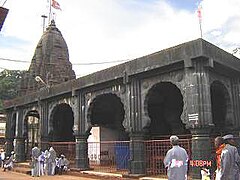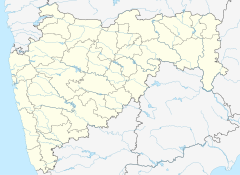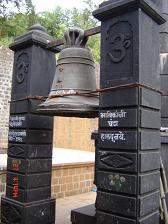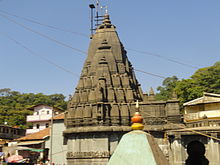Bhimashankar Temple
From Wikipedia, the free encyclopedia
| Bhimashankar Temple | |
|---|---|

Bhimashankar (Maharashtra, India)
| |
| Name | |
| Other names | Moteshwar Mahadev |
| Proper name | Bhimashankar Shiv Mandir |
| Devanagari | भिमाशंकर |
| Geography | |
| Coordinates | 19.072°N 73.536°ECoordinates: 19.072°N 73.536°E |
| Country | India |
| State | Maharashtra |
| District | Pune |
| Location | Bhimashankar |
| Culture | |
| Primary deity | Bhimashankar (Shiva) |
| Important festivals | Mahashivratri |
| Architecture | |
| Architectural styles | Nagara |
Bhimashankar Temple is a Jyotirlinga shrine located 50 km northwest of Khed, near Pune, in India. It is located 127 km from Shivaji Nagar (Pune) in the Ghat region of the Sahyadri hills. Bhimashankar is also the source of the river Bhima, which flows southeast and merges with the Krishna river near Raichur. The other Jyotirlinga shrines in Maharashtra are Vaidyanath near Parli Dist Beed, Trimbakeshwara near Nashik andGrishneshwar near Ellora around Aurangabad,Nagnaath in Aundh built by Pandav brothers in one night during their exile.
Contents
[hide]Jyotirlinga[edit]
As per Shiv Mahapuran, once Brahma (the Hindu God of creation) and Vishnu (the Hindu God of saving) had an argument in terms of supremacy of creation.[1] To test them, Shiva pierced the three worlds as a huge endless pillar of light, the jyotirlinga. Vishnu and Brahma split their ways to downwards and upwards respectively to find the end of the light in either directions. Brahma lied that he found out the end, while Vishnu conceded his defeat. Shiva appeared as a second pillar of light and cursed Brahma that he would have no place in ceremonies while Vishnu would be worshipped till the end of eternity. The jyotirlinga is the supreme partless reality, out of which Shiva partly appears. The jyothirlinga shrines, thus are places where Shiva appeared as a fiery column of light.[2][3] There are 64 forms of Shiva, not to be confused with Jyotirlingas. Each of the twelve jyothirlinga sites take the name of the presiding deity - each considered different manifestation of Shiva.[4] At all these sites, the primary image is lingam representing the beginningless and endless Stambhapillar, symbolizing the infinite nature of Shiva.[4][5][6] The twelve jyothirlinga are Somnath in Gujarat, Mallikarjuna at Srisailam in Andra Pradesh, Mahakaleswar at Ujjain in Madhya Pradesh, Omkareshwar in Madhya Pradesh, Kedarnath in Himalayas, Bhimashankar in Maharastra, Viswanath at Varanasi in Uttar Pradesh, Triambakeshwar in Maharastra, Vaidyanath Jyotirlinga, Nageshwar Temple, Dwarka|Nageswar]] at Dwarka inGujarat, Rameshwar at Rameswaram in Tamil Nadu and Grishneshwar in Maharashtra.[1][7]
Architecture[edit]
The Bhimashankara temple is a composite of old and the new structures in the Nagara style of architecture. It shows the excellency of the skills achieved by ancient Vishwakarma sculptors. It is a modest yet graceful temple and it dates back to 13th century and the sabhamandap developed in the 18th century by Nana Phadnavis. The shikhara was built by Nana Phadnavis. The great Maratha ruler Shivaji is said to have made endowments to this temple to facilitate worship services. As with other Shiva temples in this area, the sanctum is at a lower level.
Although the structure here is fairly new, the shrine Bhimashankaram (and the Bhimarathi river) have been referred to in literature dating back to the 13th century CE. Saint Jñāneshwar is said to have visited Tryambakeshwar and Bhimashankar. A unique bell (Roman style) can be seen in front of the temple which was presented by Chimaji Appa (Brother of Bajirao Peshwa I and uncle of Nanasaheb Peshwa). Chimaji Appa collected five large bells after he won in war against the Portuguese from Vasai Fort. He offered one here at Bhimashankar and the others at Menovali near Wai in front of a Shiva Temple on the banks of the Krishna river, Banshanker temple( Pune), Omkareshwar Temple( Pune) and Ramlinga temple ( Shirur)
Surroundings[edit]
There are Buddha style carvings of Amba-Ambika, Bhootling and Bhimashankar in the hills of Manmaad near Bhimashankar at a height of 1034 metres. A big bell in Hemadpanthi structure built by Nana Phadanavis is a feature of Bhimashankar. Places that can be visited in are Hanuman Lake, Gupt Bhimashankar, Origin of River Bhima, Nag Phani, Bombay Point, Sakshi Vinayak and a lot more. Bhimashankar is a reserved forest area of 130.78 km2 was declared as wildlife sanctuary in 1985.This sanctuary is a part of Western Ghat, so it is rich in floral and faunal diversity. A variety of birds, animals, insects, plants can be seen. A rare animal Malabar Giant squirrel locally called as " Shekaru" can be found in deep woods. Bhimashankar is worth visiting for jungle lovers and trekkers as well as for pilgrims. This temple is very famous in Pune and people from all around the world come to visit this temple.
Other temples and shrines[edit]
There is a shrine to Kamalaja near the Bhimashankara temple. Kamalaja is an incarnation of Parvati, who aided Shiva in his battle against Tripuraasura. Kamalaja was worshiped with offerings of lotus flowers by Brahma. Shaakini and Daakini the Shivaganas who helped Shiva in the battle against the demon are also honored and worshiped here.
The Mokshakund thirtha is behind the Bhimashankara temple, and it is associated with the rishi Kaushika. There are also the Sarvathirtha, the Kusharanya thirtha where the Bhima river begins to flow eastward, and the Jyanakund.
Worship[edit]
Bhimashankar is an ancient shrine, one of the 12 Jyotirlingas of Shiva. Far away from the tumult of the urban life, peeping through the white fleecy clouds, Bhimashankar can be termed a pilgrim paradise. The dense forests surrounding the high ranges are an abode for rare species of flora and fauna. Situated at the extreme end of the Sahyadri Ranges, this place gives a wonderful view of the world around the rivers, and hill stations.
Bhimashankar is the source of the Bhima River, which flows southeast and merges with the Krishna River. With endless stretches of virgin forests, lofty peaks that seem to reach out to the heavens, and the whispering waters of the Bhima River, Bhimashankar is definitely one of God's choicest creations.
It seems as if Lord Shiva is keeping a silent vigil over the majestic ranges of the Sahyadris. The serenity interrupted only by the silent murmuring of the cool breeze and the occasional chirping of birds, Bhimashankar is a trekker's delight and a traveler's sojourn.
Transportation[edit]
The route to Bhimashankar from Pune is via Manchar. The second route is from Rajgurunagar via Wada. One can go to this place, full of natural beauty and lovely scenery, and be back to Pune in one day. Bhimashankar is a good paradise for nature lovers, trekkers, jungle lovers and bird watchers. The best seasons to go are monsoon and winter.
Bhimashankar is 74 miles or 127 km from Pune by road. State buses go there from Pune daily, with more than five hours of bus journey. During the Mahashivaratri festival, when there is a great fair at the temple, buses ply to and fro daily. It is accessible from Karjaton the Pune — Mumbai section of the Central railway. There is no proper road from Karjat to Bhimashankar and only the devotees who wish to go to the temple on foot during festivals use this road.
If coming from Aurangabad or Ahmednagar, move towards Alephata which is 30 km from Nagar. Then go to Manchar which is 60 km from Alephata. Take right from Manchar and after 59 km to reach Bhimashankar (Aurangabad to Ahmednagar is 112 km).
Another route is via Sangamner, which lies on Nashik-Pune Road; from Sangamner go to Manchar and then follow the same route towards Bhimashankar, which is 59 km.
From Pune ST buses are available from Shivaji Nagar Pune to Bhimashankar at 5:30 in the morning to 2:00 pm and a ticket is approximately 91/-. From Pune -> Rajguru Nagar -> Chas Kaman Dam -> Wada -> Bhimashakar; from Pune -> Rajguru Nagar -> Manchar -> Ghodegoan -> Bhimashakar; from Mumbai ->Chakan [i.e., exterior part of Pune] -> Rajguru Nagar(Khed) -> Manchar -> Ghodegoan -> Bhimashakar.
From Mumbai[edit]
If coming from Mumbai, take Pune road. About 31.02 km from Deonar traffic junction lies the Mumbai Pune Expressway (NH-4) after crossing Navi Mumbai and Panvel. After 52 km from Panvel is Lonavala and 50 km from there is on NH-4 is Wadgaon. At Wadgaon, turn left on State Highway towards Chakan which is about 12 km. At Chakan, take NH 50 towards Manchar which is around 65 km to Bhimashankar. From Mumbai direct State Transport buses are available from Kurla Nehrunagar and Kalyan. you can go by changing buses. ST buses are available for Ghodegaon and Manchar from Mumbai central, Parel and Kurla Nehrunagar. after reaching Ghodegaon or Manchar next journey is easy due to more frequecy of buses. Traveling from Mumbai to Bhimashankar takes 6 hours by private car and state transport vehicles takes 8 hours. Alternatively u can go via Kalyan also. Go to Kalyan from Mumbai via thane. From kalyan take Mumbai-Nagar highway. It is via Murbad. After reaching Bankarphata which is 2 hours from kalyan, turn right for Junnar. From Junnar Go to Ghodegaon which 40 minutes journey. From Ghodegaon Bhimashankar is 47 km away. this way is through Malshej ghat which is often closed in heavy rains. So avoid this route in monsoon. you can visit fort Shivneri while going through this route near Junnar. On this way u can go in Malshej ghat. one of the Ashtavinaayak Lenyaadri is also in this way. ώ
From Pune[edit]
If starting from Pune, drive along the Pune-Nasik highway and turn off at the road leading to Bhimashankar. The mountain road is quite a steep climb. The distance is about 160 km from Pune.
Government MSRTC buses (non luxury) run from Pune to Bhimashankar every 30 minutes from 5:30 am till 4:00 pm. You can get State Transport buses from Shivajinagar, Pune. The fare is Rs. 124 and it takes around 3–4 hours to reach there from Pune.
Accommodation[edit]
Pilgrims usually stay here for three days. The local upajjhayas (priests) make arrangements for the lodging and boarding of pilgrims at a small cost. Visitors are accommodated in either temporary hutments or in dharamshalas near the village. A new dharamshala is under construction. There are several hotels near Bhimashankar. Places like Shinoli and Ghodegaon are good for staying near Bhimashankar. Accommodation at Bhimashankar mainly comprises two bungalows (with a capacity of 8 beds) and tents.
Visit times[edit]
The best time to visit is between August and February. Though any time of the year is good to visit Bhimashankar, it is better to avoid visiting during summer. Similarly during monsoon unless one likes trekking, it is better to avoid. That leaves the best period to seven months between August and February.
City details[edit]
The Khed/Rajgurunagar is the administrative taluka in Pune district, comprising the upper reaches of the Ghod and Bhima rivers. The most famous place in this division is Bhimashankar Temple, located in the village of Bhorgiri 50 km in the north west of Khed. It is located 127 km away from Pune in the Ghat region of the Sahyadri hills. It is also the location of the Bhimashankar Wildlife Sanctuary, a popular weekend getaway from Mumbai and Pune. It is about 130 km from Pune by Road and 62 km away from Manchar. Bhimashankar comes under Pune District.
Story & History[edit]
Long ago in the dense forests of Dakini, on the lofty ranges of the Sahaydris lived an evil Asura by the name Bhima with his mother Karkati. Compassion and kindness shivered in the presence of Bhima. The divine and the mortals were scared of him alike. But he was confronted by certain questions about his own existence which continuously tormented him.
When Bhima could no longer sustain his agony and curiosity, he asked his mother to unveil the mysteries of his life. He urged his mother to tell him who his father was and why he had abandoned them in the wilderness of the forest. After much hesitation and with a lingering fear, Karkati his mother, revealed to him that he was the son of the mighty Kumbhakarna, the younger brother of the Lankadheeswara — the mighty all powerful King Ravana of Lanka.
Lord Vishnu in his incarnation as Lord Rama annihilated Kumbhakarna. Karkati told Bhima, that his father was killed by Ram in the great war. This infuriated Bhima and he vowed to avenge his father. To achieve this he embarked on a severe penance to please Lord Brahma.
The compassionate creator was pleased by the dedicated devotee and granted him immense prowess. This was a terrible mistake. The evil tyrant caused havoc in the three worlds. He defeated King Indra and conquered the heavens. He also defeated a staunch devotee of Lord Shiva – Kamarupeshwar, and put him in the dungeons.
He started torturing Rishis and Sadhus. All this angered the Gods. They all along with Lord Brahma beseeched Lord Shiva to come to their rescue. Lord Shiva consoled the Gods and agreed to rescue them from the tyrant. On the other hand Bhima insisted and ordered Kamarupeshwar to worship him instead of Lord Shiva.
When Kamarupeshwar denied, the tyrant Bhima raised his sword to strike the Shiva Linga, to which Kamarupeshwar was doing abhishekam and pooja. As soon as Bhima managed to raise his sword, Lord Shiva appeared before him in all his magnificence.
Then the terrible war began. The holy sage Narada appeared and requested Lord Shiva to put an end to this war. It was then that Lord Shiva reduced the evil demon to ashes and thus concluded the saga of tyranny. All the Gods and the holy sages present there requested Lord Shiva to make this place his abode. Lord Shiva thus manifested himself in the form of the Bhimashankar Jyotirlingam.
It is believed that the sweat that poured forth from Lord Shiva's body after the battle formed the Bhimarathi River.
Temple[edit]
Although the present structure of the temple appears to be of comparatively recent origins, the shrine Bhimashankaram (and the Bhimarathi river) have been referred to in literature dating back to the 13th century. Built in the Nagara style of architecture, this temple is a modest yet graceful temple and dates back to the 18th century. One can also find borrowed influences from the Indo Aryan style of architecture.
It is believed that the ancient shrine was erected over a Swayambhu Lingam (that is the self emanated Shiva Lingam). It can be seen in the temple that the Lingam is exactly at the centre of the floor of the Garbagriham (the Sanctum Sanctorum). Intricate carvings of divinities interspersed with human figurines adorn the pillars and the doorframes of the temple. Scenes from mythology find itself captured in these magnificent carvings.
Within the temple precincts there is also a small shrine dedicated to Lord Shani Mahatma (also called Shaneeswara). The image of Nandi Lord Shiva's vahanam is installed as is the case with all the Siva Temples, just at the entrance of the temple.
This temple is closely associated with the legend of Shiva slaying the demon Tripurasura associated with the invincible flying citadels Tripuras. Shiva is said to have taken abode in the 'Bhima Shankara' form, upon the request of the Gods, on the crest of the Sahyadri hills, and the sweat that poured forth from his body after the battle is said to have formed the Bhimarathi river.
The Gopura-shikharam of the temple was built by Nana Phadnavis. The great Maratha ruler Shivaji is also said to have made endowments to this temple to facilitate the carrying out, of worship services. As with other Shiva temples in this area, the sanctum is at a lower level. The 'Shani temple' is located inside the main complex of the temple of Bhimashankar.
Between the two pillars outside the 'Shani' temple, one comes across an ancient huge Portuguese bell. Behind the temple, there is a small pathway that leads us to the banks of a river. "Stepping out from the Temple one is awed with a bewitching view of the virgin wilderness occasionally interrupted by the glimpses of the majestic forts on the surrounding mountains greets us."
History unveils itself in the peaks of the Sahayadris. Bhimashankar – a place where spiritual splendor merges with nature's magnificence is definitely a pilgrim's paradise. There are other temples and shrines, near the main temple. There is a shrine to Kamalaja near the Bhimashankara temple. Kamalaja is an incarnation of Parvati, who aided Shiva in his battle against Tripuraasura. Kamalajaa was worshipped with offerings of lotus flowers by Bhrama.
There is a shrine for Siva Ganams, Shaakini and Daakini who assisted Shiva in the battle against the demon. Kaushika Maha Muni is said to have done 'Tapas' (penance) there. The place where he bathed is called Mokshakund thirtham, which is located behind the Bhimashankara temple. There are also the Sarvathirtha, the Kusharanya thirtha where the Bhima river begins to flow eastward, and the Jyanakund.
Pooja Details[edit]
Three worship services are offered every day. Mahashivratri is a season of great festivity here.
Timings:
Mandir open - 4:30 am
Aarti - 4:45 am to 5.00 am
Nijarup (Original shivlinga)darshan - 5:00 am to 5.30 am
Normal Darshans and Abhishekam - 5:30 am to 2:30 pm.
No Abhishekam between - 12:00 pm to 12:30 pm.
Maha Puja (Naivedya Pooja) - 12.00 pm. to 12.30 pm
Aarti - 3:00 pm to 3:30 pm
Shringar Darshans - 3:30 am to 9:30 pm.
Aarti - 7:30 pm to 8:00 pm
Timings:
Mandir open - 4:30 am
Aarti - 4:45 am to 5.00 am
Nijarup (Original shivlinga)darshan - 5:00 am to 5.30 am
Normal Darshans and Abhishekam - 5:30 am to 2:30 pm.
No Abhishekam between - 12:00 pm to 12:30 pm.
Maha Puja (Naivedya Pooja) - 12.00 pm. to 12.30 pm
Aarti - 3:00 pm to 3:30 pm
Shringar Darshans - 3:30 am to 9:30 pm.
Aarti - 7:30 pm to 8:00 pm
(Except Pradosham on Monday or Amavasya or Grahan or Mahashivratri. Kartihik Month, Shravan Month — No Mukut and no Shringar Darshans).
This is not to be confused with the legend Mruthumjaya Lingam, where Shiva emerged from a Shivalingam to vanquish Yama the Lord of death. The Shiva Purana and the Koti Rudra Samhita refer to Bhimashankar temple in the Kamarupa country. However there is also a reference to Mount Sahya, where it is stated that Shiva — Bhimashankara appeared on the Sahayadris.
Three worship services are offered each day. Mahashivratri is a season of great festivity here.
References[edit]
Notes[edit]
- Chaturvedi, B. K. (2006), Shiv Purana (First ed.), New Delhi: Diamond Pocket Books (P) Ltd, ISBN 81-7182-721-7
- Eck, Diana L. (1999), Banaras, city of light (First ed.), New York: Columbia University Press, ISBN 0-231-11447-8
- Gwynne, Paul (2009), World Religions in Practice: A Comparative Introduction, Oxford: Blackwell Publication, ISBN 978-1-4051-6702-4.
- Harding, Elizabeth U. (1998). "God, the Father". Kali: The Black Goddess of Dakshineswar. Motilal Banarsidass. pp. 156–157. ISBN 978-81-208-1450-9.
- Lochtefeld, James G. (2002), The Illustrated Encyclopedia of Hinduism: A-M, Rosen Publishing Group, p. 122, ISBN 0-8239-3179-X
- R., Venugopalam (2003), Meditation: Any Time Any Where (First ed.), Delhi: B. Jain Publishers (P) Ltd., ISBN 81-8056-373-1
- Vivekananda, Swami. "The Paris Congress of the History of Religions". The Complete Works of Swami Vivekananda. Vol.4.
External links[edit]
| Wikimedia Commons has media related toBhimashankar Temple. |
- http://bhimashankar.shinoli.com/
- http://www.bhimashankar.in
http://www.maharashtratourism.gov.in/mtdc/HTML/MaharashtraTourism/TouristDelight/Shrines/Shrines.aspx?strpage=Jyotrilingas_Bhimashankar.html
- http://pune.gov.in/tourism/tour_rel.html
| |||
| ||







0 Comments:
Post a Comment
Subscribe to Post Comments [Atom]
<< Home